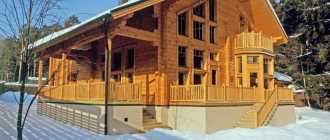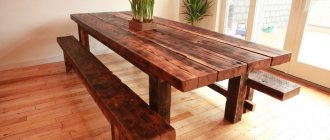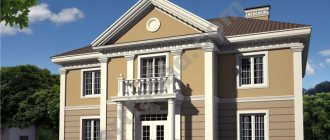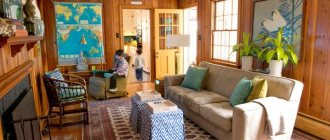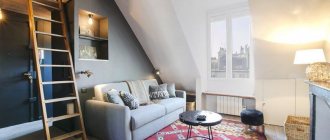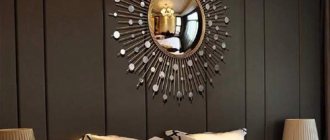- Where to place the stove in the house
- Russian with a high bed
Connecting to central heating is not always possible and economically justified. Especially when it comes to life in a dacha cooperative or a remote village. In such a situation, you can limit yourself to a beautiful brick stove for a private house; photos of the best options are in our article.
The main advantage of this heating option is the use of brick blocks. They accumulate heat and release it over a long period of time. The draft promotes ventilation of the premises, the walls of the building remain dry, which is especially important for wooden cottages.
If this is provided for by the design, you can cook food. Some models provide a special bed for resting and sleeping.
But we should not forget about the negative aspects. In particular, only the rooms directly adjacent to the heating equipment are heated. The further the room is from the firebox, the colder it will be. There is only one way to fix the problem - to equip several units. They may have combined or separate chimneys. If the cottage is compact (according to the five-wall principle), the stove is placed in the central part. From the living rooms one can admire the open brazier; in the kitchen one can cook dinner.
Types of brick stoves for the home - photos
All existing modifications belong to one of the basic variations. They are adjusted, modified in size and shape, taking into account the parameters of the room and the wishes of the customer.
Russian
The main differences from all other variations are the massiveness and the presence of a sleeping place. For pots and pans there is a wide firebox, closed with a damper. The walls are heated by smoke channels of considerable length.
Dutch
You won't be able to cook a roast on it. The main purpose is to heat rooms through special passages from bottom to top.
Heating appliances are relatively small in size. They are chosen by the owners of country houses, including two-story ones. The shape of the unit is not strictly regulated. It can be chosen based on personal preferences. One thing remains mandatory - the height exceeds the width.
Swede
It is smaller in size than the Dutch one, but in terms of efficiency and versatility it is comparable to the Russian one. You can cook food on it and dry wet shoes in special niches. The Swedish stove is a channel-type stove, but the flue gases burn out under the roof. The design is not intended for large cottages. Its power is only enough for neighboring rooms. Another application is as an addition to a standard heating system.
A significant disadvantage is the high cost of masonry due to the use of fireclay bricks. In addition, a significant part of the heat escapes through the lower part. This can be avoided if you spend money on thermal insulation.
Bell furnaces
They appeared relatively recently, but have already gained popularity due to their uniform heating and ability to retain heat for a long time. The main difference from all the previously listed options is the lack of channels.
When wood or coal is burned, smoke rises to the top of the dome. Here it slowly cools and falls down along the walls, warming them up. The internal space can consist of dozens of individual vaults, which significantly increases the efficiency of the equipment.
Bell-type structures are characterized by minimal masonry costs and the ability to quickly warm up, including in winter. The gas view will not allow the structure to cool quickly when the damper is open. The original version does not have a hob, but if necessary, it is quite easy to build it in.
The best fireplace stoves with a water circuit
Vesuvius PK-01(270) RED
Convection stove-fireplace for heating rooms with an area of up to 60 square meters. m . The firebox and ash door are made of cast iron.
The handle presses the door tightly against the body, preventing smoke from entering the rooms and suction of excess air.
Operates in two modes . The first is intense combustion with heating of the room in 60 minutes.
The second is long-term with maintaining heat for 3-4 hours on one stack of firewood. The presence of a water circuit allows you to connect the stove to a forced circulation water system.
Characteristics:
- heating volume - 150 m3;
- power - 9 kW;
- chimney diameter - 11.5 cm, connection type - top;
- functions - water circuit, flame adjustment, clean glass, 5 hours of combustion;
- complete with ash pan and hob;
- door material - glass, finishing - fireclay;
- dimensions - 43.4x81.3x50 cm;
- weight - 107 kg.
Advantages:
- fast and uniform heating of the area;
- Can be used as a regular stove;
- connecting an electric fan for turbojet heating;
- durability;
- operation in tandem with a water heating system;
- easy installation.
Flaws:
- No.
Vesuvius PK-01(270) BEIGE
This stove warms up rooms with an area of up to 60 square meters. m . The combustion chamber is equipped with a sealing cord from the inside to improve sealing.
The blower door allows you to regulate the flame, creating a long or intense burning mode . The side decorative tiles can be removed and replaced to suit the overall style of the interior.
The water circuit allows you to connect the unit to a water heating system, reduce fuel costs, and increase the time for the initial heating of the room.
Characteristics:
- heating volume - 150 m3;
- power - 9 kW;
- chimney diameter - 11.5 cm, connection type - top;
- functions - flame adjustment, clean glass, burning time - up to 5 hours;
- complete with ash pan and hob;
- door material - fireclay, lining - fireclay;
- dimensions - 43.4x81.3x50 cm;
- weight - 107 kg.
Advantages:
- quick cooking in country conditions;
- accelerated heating process of rooms and adjacent rooms;
- excellent functionality;
- long burning system;
- fuel economy;
- instant start at any time of the year;
- unique design.
Flaws:
- No.
ABX Bavaria K
Popular model from the Czech manufacturer . This is a budget sample from the line of ceramic installations, with seven shade options.
The professional York firebox operates smoothly, quickly warming up the room.
It is covered with vermiculite, which is the most fire-resistant material.
The lining protects the housing from sudden temperature changes, affects cleaner combustion of fuel, and increases efficiency.
The case acts as an excellent thermal energy accumulator, giving off heat for 6 hours.
Characteristics:
- heating volume - 200 m3;
- power - 7 kW;
- chimney diameter - 14 cm, connection type - rear and top;
- functions - long burning, clean glass;
- equipped with a niche for storing firewood;
- firebox material - cast iron, cladding - ceramics, doors - glass;
- dimensions - 74.5x74.6x45 cm;
- weight - 270 kg.
Advantages:
- wide palette of body colors;
- the convection grill speeds up the heating process during the first installation;
- the niche allows you to keep the firewood dry;
- water circuit equipment;
- possibility of connection to a water heating system;
- durability, strength.
Flaws:
- No.
META Angara Aqua
An interesting and high-performance model with a water circuit . Made of fireproof steel and ceramics. The side parts are made of glass.
You can watch the play of fire through the wide panoramic glass.
Easily connects to any heating system, which increases functionality and speed of heating of each room.
Characteristics:
- heating volume - 150 m3;
- power - 9 kW;
- chimney diameter - 11.5 cm, connection type - top and rear;
- functions - burning time - 5 hours, flame adjustment, clean glass;
- complete with ash pan and hob;
- dimensions - 43.4x81.3x50 cm;
- weight - 107 kg.
Advantages:
- adjustment of the clean glass system;
- long-term heat support;
- secondary afterburning;
- water circuit;
- decorative ceramic inserts;
- there is a heat exchanger that is easy to clean;
- A stainless steel afterburner increases the quality of combustion;
- fast cooking.
Flaws:
- No.
EdilKamin Aqua
In addition to its wide functionality, this model is capable of creating a full-fledged heating system in a dacha . The interior of the firebox is complemented by a thermal circuit made of boiler steel.
The coil lowers the temperature for increased safety, and the built-in sensor prevents the system from overheating.
The combustion chamber is covered with fireclay, which is resistant to sudden temperature changes and the destructive properties of combustion residual products.
A person receives a full-fledged boiler for efficient heating of a dacha at any time of the year.
Characteristics:
- heating volume - 325 m3;
- power - 5 kW, circuit - 7 kW;
- chimney diameter - 15 cm, connection type - top;
- Efficiency - 72%;
- complete with ash pan;
- body material - cast iron, doors - glass, cladding - ceramics;
- dimensions - 52x95x52 cm;
- weight - 154 kg.
Advantages:
- ideal for cooking;
- easy connection to the chimney and heating system;
- quick heating of the room;
- burning duration;
- durability, highest quality of all structural elements;
- attractive appearance.
Flaws:
- No.
Types of furnace equipment for gas movement
The brick warms up well and releases energy into the surrounding space for a long time. But this is not enough for high-quality heating of the kitchen or bedrooms. The heat capacity is increased due to the arrangement of special chambers that promote heating of the walls.
Without going into technical details, the movement of smoke through special channels occurs as follows:
- During the combustion of wood or coal, gases are formed that have an extremely high temperature. Under the influence of physical laws, they rise upward, but are delayed due to obstacles in the form of jumpers and valves;
- smoke begins to spread through the flues, heating the walls;
- the temperature of combustion products decreases. They go into the outlet pipe.
If the channels are laid horizontally, less time is spent on cooling than in analogues with vertical ones. The reason is the low air speed. The inevitable consequence is uneven heating of the rooms.
If we analyze all existing types of stoves, it is preferable to choose units with chimneys laid from the bottom up. No additional effort is required to move the gas. They inevitably move upward and warm up the surrounding space.
But equipment with a vertical chimney is not without its drawbacks. If, in the presence of horizontal channels, the space around the firebox warms up more, then here the heat accumulates in the upper part. The first option is more consistent with fire safety standards.
Another important point concerns furnaces with vertical channels. They should not be too long. The gas passing through them will cool down greatly. The result is uneven heating.
In bell-type heaters, it was possible to partially eliminate the disadvantages associated with heat distribution. Here, separate outlets open into a single chamber. The smoke passes through small-diameter holes and is collected in a hood under the upper ceiling. The combustion products partially cool and fall down. Then they rush into the atmosphere, obeying the natural forces of nature.
In terms of heat capacity, bell-type units are better than their analogues. They are chosen when it comes to heating a house of a large area. If you need to heat a small building at the dacha, a Dutch or Swedish one is enough.
Brick kiln performance
The task of any stove is to compensate for heat loss during the cold season. Cooking food and drying things are additional, albeit important functions. But when calculating power they are practically not taken into account.
The main parameter is the thermal characteristics of the building. To calculate them, energy losses through the floor, walls, ceiling, doors and windows are added up. If the building has ventilation ducts, they must be taken into account. The productivity of a Dutch or Swedish woman should exceed the obtained value by 10-15%. Otherwise it will be cold in winter.
During the use of stoves for a red brick house (pictured), the interdependencies between the area of a separate room and heat loss under different conditions, for example, in the presence of only one or two external walls, were experimentally established.
In the second case, the calculations become more complicated, since the height of the ceiling is taken into account. If the surfaces of the firebox face the rooms and are closed, correction factors are used. They allow you to correct the data.
How often should you light the stove?
Taking into account how often fuel has to be loaded, all units belong to one of the groups listed below:
- periodic action. Firewood or coal is added from time to time. The combustion temperature can reach 1000 0C. To avoid fire and premature destruction of the structure, the wall thickness should start from ¾ brick;
- continuous burning. Heat is not accumulated. The density of the walls does not exceed ½ stone. The firebox is of shaft type. In the standard version, firewood smolders for up to a day. Energy is released evenly, in relatively small portions.
The second type of firebox requires large volumes of oxygen to operate. They are recommended for homes with permanent residence. At dachas and cottages used only on weekends, it is better to choose designs with periodic action.
In relation to the previously discussed types of equipment, the following must be indicated:
- Russian stove. During the cold season it is heated continuously. The body should not cool down. Otherwise, condensation will accumulate in the channels. The brick gets wet and cracks during subsequent ignition. In the summer months, by moving the valves, the fumes from the firebox are directed directly into the chimney. There is no heating effect;
- Dutch. After ignition, it warms up in a few minutes. But it cools down just as quickly if you don’t close the view in time. Recommended operating mode: continuous smoldering;
- Swede. In winter, it cannot be cooled completely due to accumulating condensation. The masonry can completely collapse within a few months;
- bell-shaped Operation in any mode is allowed. Warm up in a few minutes.
How to choose a stove for a red brick house - photo
If we are talking not only about heating, but also about complementing the interior, you can give preference to a round Irish stove. The thickness of the walls is ¼ stone. To give additional strength and increase heat transfer, a metal frame is “put on top”. It will strengthen the masonry and allow you to decorate the outer surfaces with forging.
If there are always people in the building, and there is a desire to cook food on wood or coal, you should choose a square or rectangular design, for example, Russian or Swedish. If you need a fireplace more as a stove for your home, pay attention to thin-walled Dutch or round Irish stoves. They are ideal if you don't need a special cooktop. And the front surface can be decorated with elegant tiles. They can become both an addition to the interior.
Do you want to stop using a gas stove? Variations of the Swede are at your service. They will warm you up and allow you to brew coffee over an open flame. The main thing is to correctly lay out and select the source materials.
Where to place the stove in the house
The main focus is on the design phase. The quality of the drawings determines the safety, performance properties, and aesthetic appeal of heating equipment. If you don’t have your own drawing skills, it’s better to turn to professionals. When choosing a place for placement, both the type of heater itself and the area of the cottage or part of it that is planned to be heated are taken into account.
Selection of working tools
Then you can move on to the tools. For work you will need:
- jointing With its help, concrete is poured into the seams;
- trowel;
- pick;
- shovel for mixing and supplying the solution;
- special line.
Materials
The next stage is purchasing the material. The heat transfer of the stove and its durability will depend on the quality of the brick. The rules are as follows:
- the outer surface is made of brick (grade M-500). They do not crack, do not lose their consumer properties during periodic heating or cooling;
- Only refractory bricks are suitable for the combustion chamber.
In addition, you will need sifted sand and high-quality clay.
Laying the foundation
Materials have been purchased. You can move on to the construction stage. It is important to understand that the stove must stand on a strong and high-quality foundation. It is better to lay it at the same time as the base of the entire house.
If the decision to build a Dutch or Swedish one is made only now, you will have to:
- dig a hole. On each side there should be at least 20 cm to the walls;
- level the bottom and fill it with sand, followed by thorough compaction;
- lay a waterproofing membrane;
- install formwork;
- pour concrete (1 part cement x 2.5 parts sand x 4 parts small crushed stone) to ground level. The surface of the foundation must be strictly horizontal;
- wait 5-6 days for the concrete to harden. After this, you can disassemble the formwork and lay waterproofing.
If, as a result, the foundation ends up below the floor level, it is leveled by additional pouring of concrete mixture. In the latter case, the formwork is rebuilt. The entire space around the foundation is filled with soil and thoroughly compacted.
Masonry process
First, a mixture of sand and clay, previously soaked, is prepared. It fills the gaps between the outer and inner walls. They are displayed separately, but there should be no spaces between them. The lowest rows are only made of solid brick and with a sling. Then the brick is cut taking into account the selected modification. The chopped side faces the inside of the masonry. To build a chimney you will need red burnt stones. Knowing the “castle” layout will not be superfluous. A brick chimney must be lined with a FERRUM stainless steel chimney to prevent the formation of condensation and premature destruction.
Is the oven built? There is no need to rush to melt it. You must wait at least 3 weeks.
Photo of a DIY brick oven
Read here - DIY Venetian plaster: ideas for decoration and design using plaster (145 photos and videos)
Three options for laying a stove with orders
Below is information regarding the construction of the main body of heating equipment. Laying the foundation is discussed in detail in the previous paragraph of this article. The most popular modifications are selected as examples.
Russian with a high bed
Settles in regions with cold and temperate climates. It is heated once/twice a day.
Below are descriptions of the rows:
- The first should be continuous using cement or lime mortar.
- Starting from the 2nd to the 4th, they begin to build a semblance of a well. On the front side there is a hole for baking. A prerequisite is the presence of a dressing.
- 5th - beginning of the arch. To lay it out, you will need shaped formwork, and the heels of the bricks will have to be pulled off. The operation continues in lines 6 and 7. In the 8th the vault closes.
- Rows 8 to 10 are laid out in one stone. At 11, the cold stove turns off. A layer of sand is poured on top. It should slope towards the rear.
- In the 12th, a continuous surface of refractory stone is laid out over the poured sand. This part of the firebox will be in direct contact with the fire. It is desirable that the floor is perfectly level. Does not work? You can add sand and sand the outer surface.
- Rows 13 to 16 are a crucible. Blocks - 3/4, with a sling. No masonry mortar is required at this stage. To make castles, the stones are cut to 450.
- Starting from the 17th line, the mouth and posterior surface are formed. The cooking chamber is being built. A brick with hewn heels is placed on its edge.
- 18th. The furnace walls are laid out. To fill the free space between the individual chambers you will need sand. You can add cut heels to it.
- 19th - laying out the vaulted opening above the pole. Behind it is the mouth.
- 20th - the walls are leveled. The hole above the pole is reduced. A cross-pipe is formed.
- The 21st row is no different from the 19th.
- 22nd - the vault closes. On the right is a chamber in which soot will accumulate. The view is also located here. With its help, the chimney is blocked so that the heat does not escape into the atmosphere too quickly.
- Lines 22 to 32 - laying out the overpipe, laying the view and building a chimney channel. The cross-section of the latter is 26x26 cm.
After this, all that remains is to remove the outer pipe and mount an additional damper. It will require a steel corner or strip 3 mm thick.
Semicircular chambers can be replaced with ordinary rectangular ones.
Improved "Teplushka"
All brick ovens have one common drawback - the walls heat up unevenly. Builders are trying to solve this problem by introducing changes to the design. This is how “Teplushka” appeared. After fuel combustion, part of the gas leaves the house immediately through the chimney. The remainder goes into the channels and is intended for space heating.
Heat transfer in comparison with the classic Russian modification increases immediately by 2.5 times. Structurally, “Teplushka” is closer to its bell-type analogues. The chamber is divided into 2 parts: food is prepared in the upper part, fuel is burned in the lower part. The floor itself is supported by pre-installed posts. Additionally, there are 4 openings on the sides to allow combustion products to pass through. The minimum chimney height is 5 meters. The countdown is from the bottom of the firebox.
The main differences from the traditional version are the displacement of the channel relative to the firebox. To remove cooled gas, special holes are laid at the bottom of the channel.
Important! The damper must be closed during cooking. You can use a special peephole.
The orders for the "Teplushka" are presented in numerous diagrams. The main requirement is that to increase heat transfer, the ceiling installed in line 21 is carefully covered with a mixture of sand and debris.
Simple stove with shield
This option is for those who want to build a stove at their dacha or in a small country cottage (no more than 20 square meters) with minimal costs, including temporary ones. The firebox is made of fireclay clinker, optionally red solid (provided that only coal will be used as fuel).
Cooking and burning fuel are in separate chambers. Gases pass through the cooking chamber and pass into the chimney. Photos of brick stoves for the home allow you to see in detail all the necessary masonry sections.
A horizontal channel is installed at the very bottom. Thanks to it, the air near the foundation warms up well. A microclimate favorable for humans is created in the room.
Types of brick stoves for the countryside
Those uninitiated in this topic cannot even imagine how many different designs have been created by craftsmen throughout the history of mankind, in different parts of the planet. Therefore, there is no need to invent something of your own, but you can use it and choose the most suitable option for yourself. Is a wood-burning brick stove needed only for cooking or just for heating? Or is there a need for both?
Wood-burning stoves for a brick cottage are divided into 3 types according to their functional purpose:
- heating;
Wood heater
This is the most common type that is used in country houses. The design of these models is elementary, and the masonry is simple - in a nutshell, it is a chamber for burning fuel, an ash pan for combustion products and a chimney for exhausting gases.
Here we can distinguish designs with a closed combustion chamber (classic version), and with an open one (fireplaces). In the first case, heating of the room occurs through heat transfer from the walls of the structure, and in the second - from open fire.
The advantage of fireplaces is their decorative nature, i.e. in creating aesthetics. The only drawback is that they cannot heat more than one room.
- for cooking;
Wood-burning stove
This option is also not structurally complex. As a rule, zealous householders build such a model in their country houses, even in cases where there is access to other energy sources. Its dimensions are small, installation is simple, and the design assumes the presence of a hob for cooking; many also equip it with a water tank: it warms up quickly and requires few resources.
- combined.
Combined option
Cooking and heating options include all the possibilities and advantages of the types described above - the whole set of “tools”: heating the room, cooking, both on the hob and in the oven, can have compartments for drying clothes and various gardening gardening supplies.
A cottage with a small brick oven.
In addition, there are extended versions that provide additional functions in their design. For example, this could be connecting thermal water circuits to heat rooms and other household facilities, as well as adding an element such as a fireplace to the design.
Among other things, heating systems are divided according to design features that have developed in different cultural ethnic groups. The most characteristic differences are noticeable in Russian, Dutch and Swedish products.
Russian stove
This pride of the Russians cannot be confused with anything. From time immemorial to the present day, it has changed little - the presence of a bed, compartments for drying shoes and linen, a kind of oven for preparing traditional cabbage soup and porridge.
Russian answer
It will show itself in full glory with year-round use, but for short-term use this option is not entirely suitable. “Canned” for the winter, it will gain so much cold and moisture that it may take several days to start it, and this process of bringing it out of winter “hibernation” cannot be shortened in any way. You need to dry it slowly, since wet bricks can crack and the structure will require repairs.
The advantages include multifunctionality, high efficiency, safety, as well as unpretentiousness to the building materials used. The main disadvantages are dimensions and heavy weight.
Dutch
The Dutch analogue is an excellent option for a seasonal dacha. The duct design is simple, installation is simple, and it can be used to heat several rooms. The classic option is a mini brick oven.
Classic Dutch
Compared to the Russian one, this product is significantly smaller in size, which is a definite plus, especially for small houses. She will not block the passages. Minimum dimensions – 50x50cm.
Dutch ovens are considered budget-friendly because their construction requires less material and significantly less fuel for heating. The design channel feature of the Dutch oven allows it to warm up in a short time, showing good efficiency indicators.
The thin-walled partitions of these models, combined with their small dimensions, make the Dutch one light in weight, therefore it can be erected not only on the first floors, like a Russian one, but also on the second.
The disadvantages include:
- demands on building materials for heating the furnace;
- use of dry, high-quality firewood;
- when the view is open, reverse thrust is sometimes observed;
- They use smoldering mode for heating, and this is unsafe.
Swede
A Swedish stove is a compact stove for cooking food and heating your home. It is similar to the Dutch one because it has similar dimensions, also starts up quickly and quickly begins to give off heat.
Swede
The presence of a brewing compartment in this design adds its own peculiarity. With the help of a Swedish stove, you can warm several rooms, as well as cook food. It does not have an oven, but the hob is enough for basic needs.
Heating of several rooms occurs due to the specific placement of the Swede - the location of the stove in two adjacent rooms at once. The front side of the stove, where there is a hob, faces the kitchen, and the back heating side faces the other room.
The disadvantages are similar to the Dutch one - requirements for building materials, fuel, rapid cooling, smoldering mode.
Advantages of a brick kiln
The main advantage of Swedes and bell-shaped variations is their heat capacity. If you choose the right place for placement and lay it out without errors, you can maintain a comfortable temperature in 4 rooms at once using one device.
Additional advantages include:
- independence from central heating;
- environmental cleanliness. If you don’t throw plastic yogurt jars into the firebox, a minimum of harmful substances will be released into the atmosphere;
- unpretentiousness in care and maintenance;
- the ability to choose a completely unique exterior design.
Another important aspect is the creation of a favorable microclimate in the rooms. The air does not dry out, and the walls warm up well.
Tips from the professionals
A brick stove in a wooden house will create an aura of warmth and comfort - interior photos confirm this. But its masonry should be treated with special attention.
On specialized websites, experts and amateurs share their experiences and present ordering schemes. You can also find plenty of finishing tips.
To summarize the most frequently encountered recommendations, we can highlight the following:
- special attention to the dressing and thickness of the seams. The last parameter must be the same throughout the array;
- brick blocks are pre-soaked in water;
- for cutting you will need a grinder with diamond wheels;
- In the smoke ducts on the walls, no cement should be visible from the seams.
Main advice: if you have no experience in construction work at all, it is better to initially contact a specialized company.
Peculiarities
A Russian stove in the kitchen interior creates coziness throughout the house, and besides, its use is much more economical than the use of gas. Of course, it requires more self-care, but this is compensated by its unique advantages and capabilities. But before we look at them, let's talk about the design features.
Modern brick stoves for the kitchen can be of the following types:
- Heating;
- Cooking;
- Combined (heating and cooking).
Combination ovens are designed to heat a home, cook food, bake bread and heat water. The cooking chamber in such stoves, as a rule, is located deep in the structure and has a gas threshold - a wall between the mouth and the cooking chamber. Thanks to this, fuel raw materials stay under the roof longer and burn more densely.
The stove usually has two dampers for smoke, and there must be a hog, which is also made of brick in the attic. The basis of the entire structure is guardianship. In addition, today it is not uncommon to find a kitchen stove with an oven, hob, fireplace, and numerous niches and shelves for storing kitchen utensils. Yes, you can see everything yourself by looking at the photo below.
Design with hob and oven
Stove with oven, hob and dome hood
Stove-fireplace
Usage
Even in the old days they said: “The oven is like our own mother” - without it it was impossible to imagine life in the village. It should be noted that to this day in many dilapidated houses it remains standing to delight with its comfort and soft warmth. Is a stove needed in a country or country house? Today, almost everyone has gas stoves and ultra-modern heaters, but even despite this, the Russian stove remains a unique and irreplaceable element in the house. Wooden kitchen shelves are perfect for this stove.
Luxurious finishing!
- Cooking food. Boil, fry, steam, simmer, bake, dry berries and mushrooms - everything is possible here! Moreover, the dishes turn out to be simply amazingly tasty and also healthy. The main thing is to stock up on suitable utensils, a poker for mixing coals and grips.
- Heating. A wood-burning stove for the kitchen heats the entire house evenly, accumulating heat and releasing it gradually, over quite a long time. Unlike other types of stoves, a wood stove produces a gentle heat, which creates a particularly pleasant climate in the house. This can be explained by the fact that brickwork does not heat up to very high temperatures, like steel or cast iron surfaces. You can snuggle up to the brick structure after a winter walk and quickly warm up.
- Treatment. A brick kitchen stove can not only feed and warm, but also heal. As you know, the heat coming from bricks has healing properties that are great for joint pain and colds. That is why in past times people, young and old, loved to warm themselves and sleep on stoves. By the way, today you can order or build a stove with a stove bench yourself.
- Other positive aspects. Wood heating is reliable, cheap and simple. A modern wood-burning kitchen stove takes up little space, consumes little wood and, if used carefully, can last 20-30 years. In addition, such a Russian work will certainly become the decoration and pride of the whole home!
Accommodation
As mentioned earlier, brick stoves can be heating, heating-cooking or combined. Therefore, the location for such a structure is selected based on its purpose.
- It is best to place the heating stove in the middle of the room - this way each of its walls will give off heat, which will better warm the room. And if the structure is adjacent to the street on one or both sides, then its effectiveness will be significantly reduced.
- Of course, it is better to place a combination oven in the kitchen.
Combined design
Advice! Before starting major masonry, it would be good to build some kind of model of the furnace, or, more simply, to practice. Then the masonry skills will be there, and the mistakes made can be seen.
Masonry
In this article we will not describe all the nuances of this labor-intensive, individual, but very interesting process. Let's consider only the general features during installation.
So, a little instruction:
- The distance between the roof slabs and the chimney pipe should not be less than 15 cm. After this aspect has been taken into account, it is necessary to mark the place for the foundation of the stove. It is better to make it a little larger than the rest of the structure.
Important! The foundation must be waterproofed.
- The masonry can be very different: for example, with empty seams, or undercut masonry.
- The brick is laid depending on the desired wall thickness. They can be laid out either in one brick, or in half or ¾.
- For the construction of the structure, it is recommended to choose a special stove brick (red brick or solid brick). Under no circumstances should you use bricks from dismantled buildings, expanded clay blocks and slotted bricks!
Kiln brick
- Laying begins with the first row, which is laid without mortar. At this stage, the bricks are aligned, the front wall and the location of each door are determined. Then the brick is already “set” on the mortar.
- During the installation process, you must constantly monitor the correctness of the masonry. It must go strictly vertically. Particular attention should be paid to the corners - all other work depends on the correctness of their layout.
Furnace structure
Reference! Old skilled craftsmen use twine as a vertical guide during the laying process - in their opinion, this is the most convenient way to avoid mistakes.
- Then, depending on the chosen design model, places for the combustion chamber, ash pan and ash pan are designated. It should be noted that usually the ash pan is placed after the third row of masonry, and after another row there is an ash pit. And only then the firebox is installed. But laying the furnace roof begins above the firebox, after the second row of bricks.
- When installing a chimney, it is necessary to provide a special valve, which should be adjusted without difficulty.
Finishing
When the oven heats up, the brick and finishing material expand. But the main problem is that they expand by different amounts. Why is this happening? First of all, due to the difference in the thermal expansion coefficients of these two materials. Secondly, due to the inertia of heating the kiln walls - that is, at the moment when the finishing layer is still completely cold, the brick is already actively expanding. Therefore, if the brick is in tight and even tight contact with the finishing layer, then deformation of the second cannot be avoided. There have been cases where tiles have broken in two when using very strong mortars. So keep that in mind.
Well, of all the existing types of finishing, we would like to highlight the following:
- The cheapest type of finishing that is used to decorate wood-burning kitchen stoves is daub (unevenly applied hand plaster with painting or whitewash). There may be small cracks in such decorative finishes, but they are only superficial and “temporary” in nature and do not cause any problems. You don't have to pay any attention to it at all. And in a modern kitchen, such a finish can become a real “highlight”, reminiscent of the good old days.
Example of a mud hut
- Tiles are another option for decorating the front surface of the structure. These ceramic products are attached to the brickwork using anchors. They can be plain white, painted or have a different relief surface. Perhaps, tiles are the most expensive type of stove finishing today (there are even sets of tiles, the price of which is several times higher than the cost of the stove itself). The kitchen couch will fit perfectly into the interior with a Russian stove.
Tiles finishing
Decorating with tiles is a real art!
Words will be superfluous here!
- A beautiful brick - it does not withstand direct flame, but is very suitable as a decoration. As a matter of fact, there is no finishing layer at all, which means there is simply nothing to fall off!
Please note - some parts of the stove are decorated with different bricks
- Wood-burning stoves for the kitchen can be finished with other materials: tiles, wallpaper over plaster, stone tiles. But in our opinion, all these options are impractical.
- Separately, it should be said about the modern solution to this issue - a separate frame structure with an indentation from the stove. Thus, around any stove you can build a metal frame with an indentation for convection, and then stick any decorative non-combustible material on it. Of course, the dimensions of the structure will be slightly increased, but in terms of design you will have no restrictions! In addition, the frame can be made collapsible.

